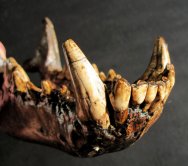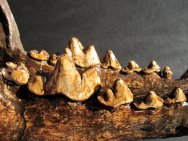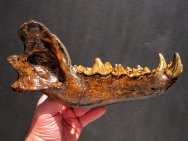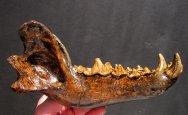 Description:
These kinds of fossils are just not commercially available. The
Le Brea (tar) pit fossils were available back in the 50s-80s,
just the time the Spinner collection was being accumulated. They
are now only available from such old collections This magnificent
Dire Wolf fossil jaw section speaks for itself. It has a rich
provenance. It’s
the only one I have, with no expectations to obtain another in
the future. Description:
These kinds of fossils are just not commercially available. The
Le Brea (tar) pit fossils were available back in the 50s-80s,
just the time the Spinner collection was being accumulated. They
are now only available from such old collections This magnificent
Dire Wolf fossil jaw section speaks for itself. It has a rich
provenance. It’s
the only one I have, with no expectations to obtain another in
the future.
The
Dire Wolf, Canis dirus, is an extinct carnivorous mammal of the
genus Canis,
and 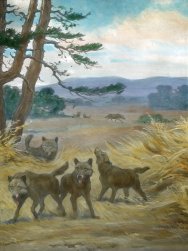 was most common in North America and South
America from the Irvingtonian stage to the Rancholabrean stage
of the Pleistocene epoch living 1.80 Ma – 10,000 years ago,
existing for approximately 1.79 million years. Although it was
closely related to the Gray Wolf and other sister species, Canis
dirus was not the direct ancestor of any species known today. Unlike
the Gray Wolf, which is of Eurasian origin, the Dire Wolf evolved
on the North American continent, along with the Coyote.[1] The
Dire Wolf co-existed with the Gray Wolf in North America for about
100,000 years. was most common in North America and South
America from the Irvingtonian stage to the Rancholabrean stage
of the Pleistocene epoch living 1.80 Ma – 10,000 years ago,
existing for approximately 1.79 million years. Although it was
closely related to the Gray Wolf and other sister species, Canis
dirus was not the direct ancestor of any species known today. Unlike
the Gray Wolf, which is of Eurasian origin, the Dire Wolf evolved
on the North American continent, along with the Coyote.[1] The
Dire Wolf co-existed with the Gray Wolf in North America for about
100,000 years.
The Dire Wolf was one of the abundant Pleistocene megafauna—a
wide variety of very large mammals that lived during the Pleistocene.
Approximately 10,000 years 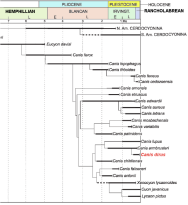 ago the Dire Wolf became extinct along
with most other North American megafauna ago the Dire Wolf became extinct along
with most other North American megafauna
At
the end of October, 2010 I acquired a large percentage of the
Paul Spinner Collection from his fossil estate manager. Paul was
a Native American who worked for the U.S. Forrest Service and lived
in the western side of Kern County, California. During the 1950s
through the early 1980s he accumulated his collection from Fresno
county, the Lompoc area fish beds, Sharktooth Hill bone beds, Kern
County Brea (tar) pits, etc. As his reputation grew for having
the largest privately held and valuable fossil collection from
these areas, he developed a special  relationship with the University
of California Santa Barbara department of Paleontology as well
as the La Brea Tar Pits staff. This unique collection of Southern
California fossils was primarily from the Cenozoic, with an emphasis
on the Miocene. relationship with the University
of California Santa Barbara department of Paleontology as well
as the La Brea Tar Pits staff. This unique collection of Southern
California fossils was primarily from the Cenozoic, with an emphasis
on the Miocene.
Unfortunately,
the collection was left with no identifications for time, location,
species or age. This is where the mystery lies.
The vast majority of the specimens are easy to identify under the
trained eye of a commercial dealer, or paleontologist. Locations
are somewhat tricky, however. The matrix surrounding the fossil,
or the fossil itself often is evidence of location. This dire wolf
jaw shows the dark oily looking exterior of a Brea (tar) pit specimen.
But, was this specimen discovered in the LaBrea tar pits of Los
Angeles? The estate manager of the collection told me that Paul
Spinner had collected in the LaBrea pits, possibly with the permission
of one of the academic institutions he was affiliated with. It
is possible he collected this back in the 50’s or 60’s
before the pits became a strictly administered academic sanctuary.
Otherwise it came from some other Brea (asphalt) pit located in
the S. California, Kern County area. We’ll never know for
sure. Paul died back in the 80’s and his collection sat packed
away for over 25 years until now.
|




